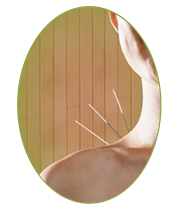
Acupuncture
Acupuncture is one of the five branches of Traditional Chinese Medicine among Chinese nutrition science, Chinese pharmacopeia, Tui na massage, and energetic exercise. Based on an energetic and holistic approach, acupuncture acts on the Chi which circulates in the body by the way of the meridian lines. Needles are inserted into the surface of the skin and make it possible to stimulate these acupuncture specific points located along the meridian lines. It is useful to regularize the chi, and to act on the physiological functions and the corresponding organic functions.
The concept of Yin-Yang equilibrium might appear archaic or exotic, yet it corresponds to occidental medicine's functional balance of the human body systems, of the nervous system (sympathetic and parasympathetic), of the acid-base “PH” balance and of the immune and homeostatic potential.
Even today, the acupuncturist analyzes and treats “modern” illnesses according to ancient texts, on the basis of principles that have stood the test of time.
The clinical efficacy of acupuncture combined with its safety and availability have contributed to its development across Asia and now in most Western countries. It is indicated for a wide variety of conditions and it is a matter of time before it is completely integrated with Western medicine. Moreover, many doctors refer their patients for acupuncture treatments, whether it is for pain, functional disorders like irritable bowel syndrome or to increase the chances of a woman suffering from infertility to become pregnant with in vitro fertilization.
You will find a more detailed explanation of Chinese medicine on
http://acupuncturetoday.com/abc/
http://www.passeportsante.net/fr/Therapies/MedecineChinoise/Index.aspx
l’Association des Acupuncteurs du Québec
Why choose acupuncture as a treatment modality?
Acupuncture has been practiced for more than 3000 years and is still being recognized by almost a quarter of the world’s population as a complete medicine.
The World Health Organisation acknowledges acupuncture as being efficient in the treatment of up to 43 illnesses (of which a list was made in 1979). See pages 23 to 27 of this pdf:
http://apps.who.int/medicinedocs/pdf/s4926e/s4926e.pdf
Since 1997, the National Institute of Health of the United States has been financing research concerning the efficiency of acupuncture as a medicine:
http://consensus.nih.gov/1997/1997Acupuncture107PDF.pdf
http://www.nlm.nih.gov/medlineplus/acupuncture.html
A growing number of doctors recommend acupuncture to their patients for cases related to the CSST and the SAAQ.
What happens during an acupuncture session?
The initial consultation in acupuncture usually lasts an hour and half. The acupuncturist first establishes a diagnosis according to the rules of Chinese medicine audit following a detailed interview with the patient and by palpation of the pulse and observation of the tongue.
Is there a risk of infection?
The needles used in treatment are pre-sterilized and disposable. When performed by a qualified acupuncturist, acupuncture is the safe treatment.
Is acupuncture painful?
There is little or no pain at the insertion of needles. Patients report a feeling of well-being during and after the sessions along with a more refreshing sleep and improved energy levels.
How many treatments does it take?
The period of treatment and frequency depend on the individual and the disease. In severe case, close sessions are necessary. For chronic illnesses, treatments are less frequent, and are provided until the patient’s health stabilizes.
Does acupuncture is covered by insurance?
The majority of insurance companies issue refunds for a great part of the costs. After a work accident or a car accident of which the medical prescription for acupuncture is accepted by the C.S.S.T and the S.A.A.Q, the cost of the treatment can be covered.
